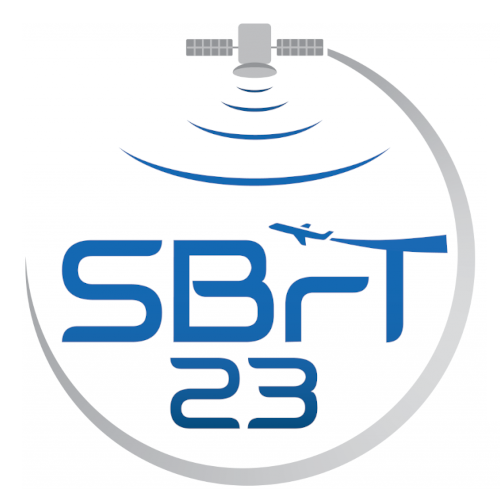
XLI Simpósio Brasileiro de Telecomunicações e Processamento de Sinais
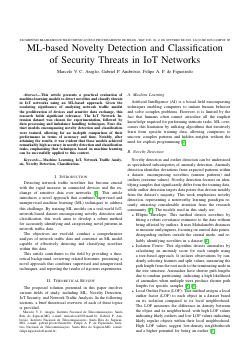
ML-based Novelty Detection and Classification of IoT Threats using Network Traffic Analysis
Marcelo V C Aragão, Gabriel P Ambrósio, Felipe Augusto Pereira de Figueiredo
DOI: 10.14209/sbrt.2023.1570923576
Keywords: Machine Learning IoT Network Traffic Analysis Novelty Detection and Classification
Abstract
This article presents a practical evaluation of machine-learning models to detect novelties and classify threats in IoT networks using an ML-based approach. Given the escalating significance of analyzing network traffic amidst the proliferation of devices and sensitive data exchange, this research holds significant relevance. The IoT Network Intrusion dataset was chosen for experimentation, followed by data processing and imbalance handling techniques. Four distinct models encompassing novelty detection and classification were trained, allowing for an in-depth comparison of their performance in terms of accuracy and time. Notably, after attaining the results, it was evident that these models achieved remarkably high accuracy in novelty detection and classification tasks, emphasizing that techniques based on machine learning can be successfully applied to this context.Download

Implementing Service Management and Orchestration for ORAN Software Community
Lucas M Matni Bezerra, Rebecca Almeida Aben-Athar, Cleverson Nahum, Ilan S Correa, Glauco Estácio Gonçalves, Silvia Lins, Aldebaro Klautau
DOI: 10.14209/sbrt.2023.1570923577
Keywords: Open Radio Access Network (O-RAN) Service Management and Orchestration (SMO) Network Efficiency Network Quality
Abstract
This study analyzes the scalability constraints of System Management and Orchestration (SMO) in O-RAN SC, mainly focusing on the increase in RAM consumption correlated with the rising count of DU/RU. The analysis unveils a significant influence on RAM utilization, emphasizing the requirement for competent resource management in ORAN infrastructures. This research contributes to understanding SMO's behavior in ORAN networks by identifying potential constraints and prospective ar- eas for future exploration. The results offer pertinent information for network operators and developers in ORAN environments, underscoring the effects of SMO on network performance.Download
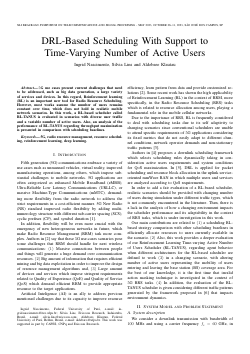
DRL-Based Scheduling With Support to Time-Varying Number of Active Users
Ingrid Nascimento, Silvia Lins, Aldebaro Klautau
DOI: 10.14209/sbrt.2023.1570923579
Keywords: 5G Radio Resource Management Resource Scheduling Reinforcement Learning
Abstract
5G use cases present current challenges that needs to be addressed such as, big data generation, large variety of services and devices. In this regard, Reinforcement learning (RL) is an important new tool for Radio Resource Scheduling. However, most works assume the number of users remains constant over time, which does not hold in realistic mobile network scenarios. In this work, an RL-based scheduler called RL-TANUS is evaluated in scenarios with diverse user traffic and with a variable number of active users. Also, an analysis of the performance of RL-TANUS regarding throughput maximization is presented in comparison with scheduling baselines.Download
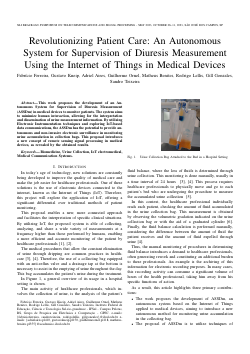
Revolutionizing Patient Care: An Intelligent System for Supervision of Diuresis Measurement (ISSDm) Using the Internet of Things in Medical Devices
Fabrício Neitzke Ferreira, Gustavo Cunha Kneip, Adriel Leal Aires, Guilherme Duarte Ornel, Matheus da Silva Benites, Rodrigo Nuevo Lellis, Gill Velleda Gonzales, Sandro Silva Teixeira
DOI: 10.14209/sbrt.2023.1570923584
Keywords: Biomedicine Urine Collection IoT electromedical Medical Communication Systems
Abstract
This work proposes the development of an autonomous, Intelligent System for Supervision of Diuresis Measurement (ISSDm) in medical devices to monitor patients. The system aims to minimize human interaction, allowing for the interpretation and dissemination of urine measurement information. By utilizing Electronic Instrumentation techniques and exploring IoT-based data communications, the ISSDm has the potential to provide autonomous and non-invasive electronic surveillance in monitoring urine accumulation in collection bags. This proposal introduces a new concept of remote sensing signal processing in medical devices, as revealed by the obtained results.Download
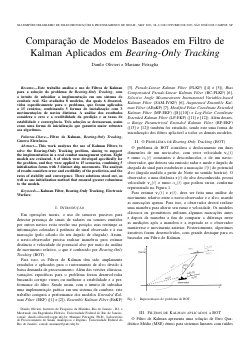
Comparação de Modelos Baseados em Filtro de Kalman Aplicados em Bearing-Only Tracking
Danilo M Olivieri, Mariane R Petraglia
DOI: 10.14209/sbrt.2023.1570923590
Keywords: Filtro de Kalman Bearing-only tracking Guerra Eletrônica
Abstract
This work analyzes the use of Kalman Filters to solve the Bearing-Only Tracking problem, aiming to support the implementation in a real combat management system. Eight models are evaluated, 6 of which were developed specifically for the problem, and they were applied to 15 scenarios, combining 5 initialization forms with 3 distinct ship movements. The analysis of results considers error and credibility of the prediction, and the rates of stability and convergence. Three solutions stood out, as well as one initialization method that ensured greater robustness to the models.Download
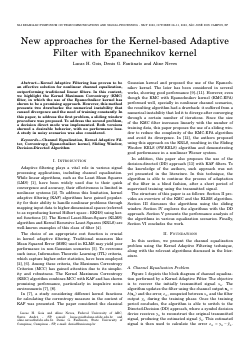
New approaches for the Kernel-based Adaptive Filter with Epanechnikov kernel
Lucas Gois, Denis Fantinato, Aline Neves
DOI: 10.14209/sbrt.2023.1570923591
Keywords: Channel Equalization Kernel Adaptive Filter Correntropy Epanechnikov kernel
Abstract
Kernel Adaptive Filtering has proven to be an effective solution for nonlinear channel equalization, outperforming traditional linear filters. In this context, we highlight the Kernel Maximum Correntropy (KMC) filter, in which the use of the Epanechnikov kernel has shown to be a promising approach. However, this method presents two drawbacks: the numerical instability that caused divergence and the need of training constantly. In this paper, to address the first problem, a sliding window procedure was proposed. To address the second problem, a decision direct mode was implemented. Both versions showed a desirable behavior, with no performance loss. A study in noisy scenarios was also considered.Download
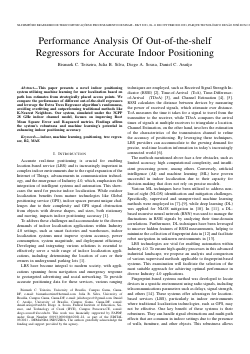
Performance Analysis Of Out-of-the-shelf Regressors for Accurate Indoor Positioning
Bismark C Teixeira, Julia B Silva, Diego Aguiar Sousa, Daniel Araújo
DOI: 10.14209/sbrt.2023.1570923594
Keywords:
Abstract
This paper presents a novel indoor positioning system utilizing machine learning for user localization based on path loss estimates from strategically placed access points. We compare the performance of different out-of-the-shelf regressors and leverage the Extra Trees Regressor algorithm's randomness, avoiding overfitting and outperforming traditional methods like K-Nearest Neighbors. Our system, simulated under the 3GPP 28 GHz indoor channel model, focuses on improving Root Mean Square Error and R-squared metrics. Findings affirm the system's robustness and machine learning's potential in enhancing indoor positioning accuracy.Download
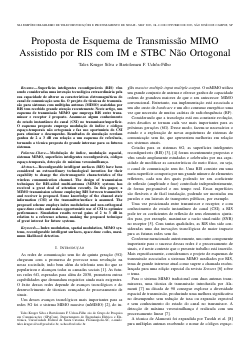
Proposta de Esquema de Transmissão MIMO Assistido por RIS com IM e STBC Não Ortogonal
Tales Kruger Silva, Bartolomeu F. Uchôa-Filho
DOI: 10.14209/sbrt.2023.1570923603
Keywords: Superfícies inteligentes reconfiguráveis Sistemas MIMO Modulação de índice Códigos espaço-temporais
Abstract
Superfícies inteligentes reconfiguráveis (RIS) vêm sendo consideradas uma invenção tecnológica extraordinária pela sua capacidade de alterar as características eletromagnéticas do canal de comunicação sem fio. O projeto de técnicas de transmissão para sistemas com múltiplas antenas (MIMO) assistidas por RIS tem recebido grande atenção recentemente. Neste artigo, um esquema de transmissão MIMO que emprega RIS entre transmissor e receptor é proposto. Assume-se algum conhecimento do estado do canal (CSI) no transmissor/superfície. O esquema proposto emprega modulação de índice e códigos espaço-temporais não ortogonais e faz uso oportunista da CSI para otimizar o desempenho. Resultados de simulação revelam ganhos de 2 a 3 dB em relação a um esquema de referência, tornando a técnica proposta de grande interesse para os futuros sistemas.Download
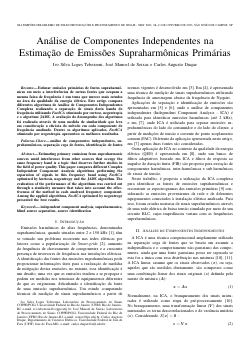
Análise de Componentes Independentes na Estimação de Emissões Supraharmônicas Primárias
Ivo Silva Lopes Tebexreni, José de Seixas, Carlos Duque
DOI: 10.14209/sbrt.2023.1570923607
Keywords: análise de componentes independentes supraharmônicos separação cega de fontes identificação de fontes
Abstract
Estimar emissões primárias de fontes supraharmônicas em meio a interferências de outras fontes que ocupam a mesma faixa de frequência é um tema que merece mais estudos na área da qualidade da energia elétrica. Este artigo compara diferentes algoritmos de Análise de Componentes Independentes Complexa na separação de sinais desta banda de frequência utilizando FastICA otimizado por curtose e por neguentropia além do algoritmo JADE. A avaliação do desempenho dos algoritmos foi realizada através de uma medida de similaridade que leva em consideração a eficácia do método em cada componente de frequência analisado. Dentre os algoritmos aplicados, FastICA otimizado por neguentropia apresentou os melhores resultados.Download
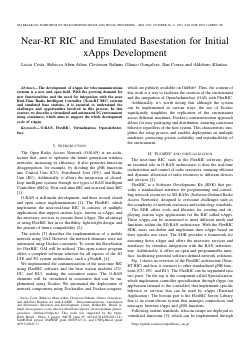
Near-RT RIC and Emulated Basestation for Initial xApps Development
Lucas Queiroz Costa, Rebecca Almeida Aben-Athar, Cleverson Nahum, Glauco Estácio Gonçalves, Ilan S Correa, Aldebaro Klautau
DOI: 10.14209/sbrt.2023.1570923608
Keywords: O-RAN FlexRIC Virtualization OpenAirInterface
Abstract
The development of xApps for telecommunications systems is a new and open field. With the growing demand for new functionalities and the need for integration with the near Real-Time Radio Intelligent Controller (Near-RT RIC) systems and emulated base stations, it is essential to understand the challenges and opportunities involved in this process. In this context, we describe a virtualized and automated 5G environment using containers, which aims to support the whole development cycle of xApps.Download